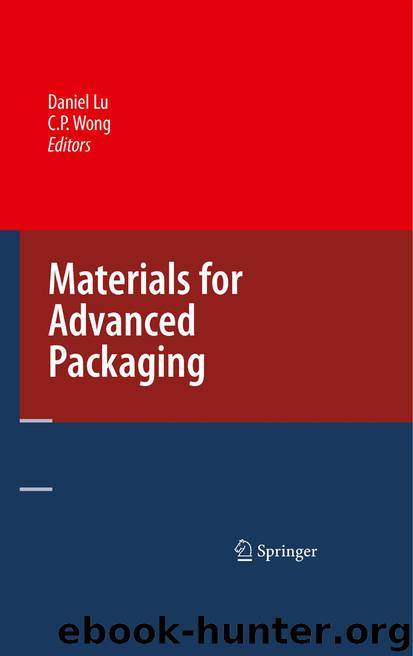Materials for Advanced Packaging by Daniel Lu & C.P. Wong

Author:Daniel Lu & C.P. Wong
Language: eng
Format: epub
Publisher: Springer US, Boston, MA
2.4 Conductive Fillers
2.4.1 Solid Metal Particles
Conductive fillers are used to provide the adhesive with electrical conductivity. The simplest fillers are metal particles such as gold, silver, nickel, indium, copper, chromium and lead-free solders (SnBi) [6, 7, 9–11]. The particles are usually spherical and range 3–15 μm in size for ACA applications [12]. Needles or whiskers are also quoted in some patents [6].
2.4.2 Non-metal Particles with Metal Coating
Some ACA systems employ non-conductive particles with a thin metal coat. The core material is either plastic or glass with a metal coating consisting of gold, silver, nickel, aluminum or chromium. The basic particle shape of these systems is also spherical. Plastic-cored particles deform when compressed between opposing contact surfaces, thus provide a large contact area. Polystyrene (PS) is often selected as the core material because the coefficient of thermal expansion of metal-coated PS beads is very close thermoset adhesives. The combination of epoxy resin and metal-plated PS beads results in a large improvement in thermal stability [7]. In addition, glass can also be selected as the core material. Glass-cored particles coated with metal lead to a controlled bond-line thickness because the glass core is not deformable. Since the conductive particle size is known, the conductivity of the joint can be predicted.
Download
This site does not store any files on its server. We only index and link to content provided by other sites. Please contact the content providers to delete copyright contents if any and email us, we'll remove relevant links or contents immediately.
| Concrete | Extraction & Processing |
| Fracture Mechanics | Materials Science |
| Metallurgy | Polymers & Textiles |
| Strength of Materials | Testing |
Whiskies Galore by Ian Buxton(41938)
Introduction to Aircraft Design (Cambridge Aerospace Series) by John P. Fielding(33092)
Small Unmanned Fixed-wing Aircraft Design by Andrew J. Keane Andras Sobester James P. Scanlan & András Sóbester & James P. Scanlan(32764)
Craft Beer for the Homebrewer by Michael Agnew(18196)
Turbulence by E. J. Noyes(7978)
The Complete Stick Figure Physics Tutorials by Allen Sarah(7338)
Kaplan MCAT General Chemistry Review by Kaplan(6900)
The Thirst by Nesbo Jo(6877)
Bad Blood by John Carreyrou(6583)
Modelling of Convective Heat and Mass Transfer in Rotating Flows by Igor V. Shevchuk(6406)
Learning SQL by Alan Beaulieu(6237)
Weapons of Math Destruction by Cathy O'Neil(6215)
Man-made Catastrophes and Risk Information Concealment by Dmitry Chernov & Didier Sornette(5956)
Digital Minimalism by Cal Newport;(5704)
Life 3.0: Being Human in the Age of Artificial Intelligence by Tegmark Max(5516)
iGen by Jean M. Twenge(5385)
Secrets of Antigravity Propulsion: Tesla, UFOs, and Classified Aerospace Technology by Ph.D. Paul A. Laviolette(5333)
Design of Trajectory Optimization Approach for Space Maneuver Vehicle Skip Entry Problems by Runqi Chai & Al Savvaris & Antonios Tsourdos & Senchun Chai(5037)
Pale Blue Dot by Carl Sagan(4953)
